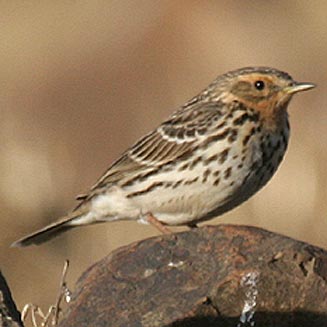|
Anthus cervinus (Red-throated
pipit)
Rooikeelkoester [Afrikaans]; Roodkeelpieper [Dutch];
Pipit de Kimberley [French]; Rotkehlpieper [German];
Petinha-de-garganta-ruiva [Portuguese]
Life
> Eukaryotes >
Opisthokonta
> Metazoa (animals) >
Bilateria >
Deuterostomia > Chordata >
Craniata > Vertebrata (vertebrates) > Gnathostomata (jawed
vertebrates) > Teleostomi (teleost fish) > Osteichthyes (bony fish) > Class:
Sarcopterygii (lobe-finned
fish) > Stegocephalia (terrestrial
vertebrates) > Tetrapoda
(four-legged vertebrates) > Reptiliomorpha > Amniota >
Reptilia (reptiles) >
Romeriida > Diapsida > Archosauromorpha > Archosauria >
Dinosauria
(dinosaurs) > Saurischia > Theropoda (bipedal predatory dinosaurs) >
Coelurosauria > Maniraptora > Aves
(birds) > Order: Passeriformes
> Family: Motacillidae > Genus: Anthus
 |
|
|
Red-throated pipit, Ethiopia. It is a rare vagrant
in southern Africa. [photo
Stephen Davis
©] |
|
Distribution and habitat
Breeds in the Arctic tundra from northern Scandinavia to
Siberia and western Alaska, heading south in the non-breeding season to Asia,
the eastern Mediterranean coast and sub-Saharan Africa, from southern Mauritania
to Somalia south to northern Tanzania. It is a vagrant to southern Africa, with
three records on opposite sides of the region: one in the Swakop River mouth in
central Namibia, another in Chirundu, Zimbabwe and finally one in Umvoti River
mouth, KwaZulu-Natal. In its non-breeding grounds it generally prefers wet,
short grassy habitats around water bodies, such as lakes, dams and pans,
especially with lots of mud.
Food
It does most of its foraging in short grass, plucking
insects from the ground.
References
-
Hockey PAR, Dean WRJ and Ryan PG 2005. Roberts
- Birds of southern Africa, VIIth ed. The Trustees of the John Voelcker
Bird Book Fund, Cape Town.
|
